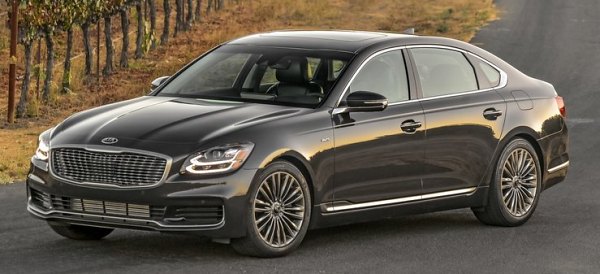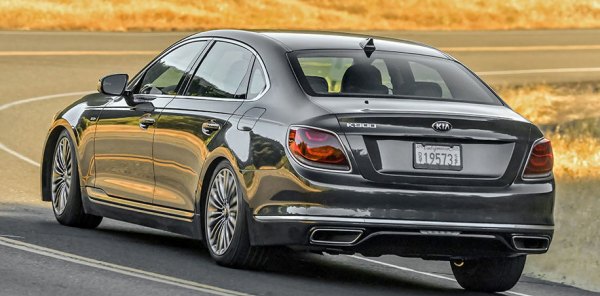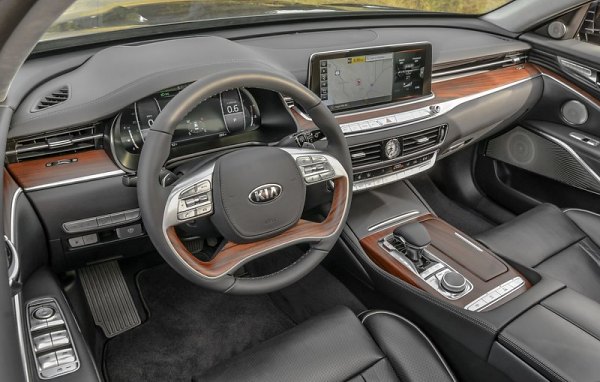Published
on 30
Dec 2018
|
All rights reserved.
|
|
|

|
|
The
second generation K9 gets closer to the global class norm, although you
won’t guess that from its looks.
|
|
It took the Japanese just
one shot to match European luxury limousines. In the late 1980s, Lexus
LS400 and Infiniti Q45 shocked the German and British luxury marques
with their high-tech engineering and high-quality finishing. The Korean
is less successful. They have been building Hyundai Equus and
Daewoo/Ssangyong Chairman for 20 years yet these cars still occupy the
very bottom of the premier league. The causes? Lack of commitment and
lack of competition. Korean enterprises never buy foreign brands, so
the Korean limousines are all sold to local enterprises. They don’t
need to be excellent, just cheap and good enough will sell well.
Unfortunately, living in the comfort zone prevents them from exporting
and competing in global level. It also works against the new strategy
of Hyundai-Kia group, which is abandoning its econo-car image and
steering towards a premium car maker like Volkswagen group. On the one
hand they founded the Genesis brand, on the other hand they hired good
people like Peter Schreyer and Albert Biermann to transform their
design and development. Now they are serious to attack the premium
segments.
Despite the said efforts, it takes time to materialize. Development of
a premium car could take 4-5 years from sketch to finish, and it
usually takes 2 generations or more to finish the transformation. 6
years ago, Kia kickstarted the change with its K9 (K900). It mated a
handsome design by Peter Schreyer with an up-to-date mechanical
package. It was not a great car though. In fact, it was slow, numb and
clumsy to handle. 3 years ago, Genesis G90 arrived as the second act.
It was not great either, but at least it showed plenty of improvements
in handling and build quality, and signs that the Korean has potential
to compete in the global luxury car market.

|
|
While
the old car rolled a lot in corner, the new car controls its heavy body
much better.
|
|
Now the second generation K9 (K900) is the third attempt, and it gets
closer to the global class norm again. You won’t guess that from its
looks, which has scaled back from the last generation to be
more traditional, more conservative. You can’t argue with that, because
buyers for such a limousine must be over 50s or 60s. BMW or Audi might
appeal to younger customers thanks to their technology and driver
appeal, but the market positioning of Korean is not there yet. It is
wise to keep pleasing its traditional Korean company car buyers while
using its improved overall package to lure more cost-concerned and less
brand-aware foreign customers. You can’t build the Great Wall in days,
but keep building generation after generation, it will be finished
eventually. I suppose the Korean is using this strategy.
The new car is again called K9 in Korea, K900 in America or Quoris in
the Middle East. It gets larger again, i.e. 60mm longer in wheelbase,
35mm longer overall and 15mm wider. This make it about as large as the
standard-wheelbase Mercedes S-class. Unlike its superior rivals though,
the Kia is constructed in steel, albeit plenty of hot-formed
high-strength steel. Aluminum bonnet is the only lightweight part in
its body. This means it is about 200kg heavier than the Mercedes.
However, steel does not compromise strength. In addition to using
structural adhesives, its torsional rigidity is lifted by 33 percent,
which helps reducing NVH. Air noise and drag are reduced by using
full underbody panels and an active air flap. Coefficient of drag is a
passable 0.27.
The car sits on the same platform as G90, sharing the same multi-link
suspensions at all corners. Electronic adaptive damping is offered, but
unlike a true luxury limousine in this class, it has neither air
suspension nor active road-scanning. There is no rear-wheel steering,
active anti-roll bars or torque vectoring either, so don’t expect a
leap
in handling.

|
|
The
V8 is more delicious to ears, but its weaker mid-range torque does not
make it feel any quicker than the 3.3T.
|
|
That said, the Kia drives well enough, at least on the sportier tuned
American K900. While the old car rolled a lot in corner, the new car
controls its heavy body much better. Turn-in is quicker, thanks in part
to the 50:50 weight distribution. Meanwhile, the suspension does a good
job to absorb bumps, at least in more civilized modes, resulting in a
composed and quiet ride. Even though without air suspension, it doesn’t
feel shortchanged. The electronic-controlled 4WD system offers plenty
of traction and security.
Nevertheless, the K900 is comfort-oriented. While its steering is
precise, it lacks weight and feel to engage the driver. Push the large
car harder in a twisty section of the road – although that is unlikely
for a car supposed to be driven by chauffeur – it will protest by
understeering heavily. In short, German limousines deceive the laws of
physics better.
The K9 offers 3 choices of engines. The value choice for company cars
is the old 3.8-liter GDI V6, offering 315 horsepower and 293 pound-foot
of torque. Much faster yet more refined is the new 3.3-liter twin-turbo
V6, which is also the mandatory engine for America. It produces 370
horsepower and a useful 376 pound-foot of torque, good enough to make
the Korean-only 5.0-liter Tau V8 superfluous. The V8 is more delicious
to ears, of course, but its weaker mid-range torque does not make it
feel any quicker than the 3.3T, so the extra weight and worse chassis
balance are not justified. The 3.3T feels quick enough for a limousine.
It is also smooth and quiet – the latter helped by the use of double
firewall. Hyundai’s own 8-speed automatic transmission might not be as
well-rounded as ZF’s, but in normal driving it works smoothly.

|
|
Materials are
richer than any Korean cars before...
|
|
Inside, the Kia flagship model offers not only a lot of space but also
much improved build quality. It is not quite as luxurious as Mercedes,
Audi or BMW, of course, but it feels classier than Cadillac CT6 and
Lincoln Continental with which it competes in price. The interior
design is a bit conservative, but it looks graceful enough. Materials
are richer than any Korean cars before, Genesis G90 included. There is
tasteful matt wood like Korean furniture, satin metal inserts and
metallic speaker grilles. Quilted Nappa leather wraps most other
surfaces. The chairs are comfy and highly adjustable. The instrument
panel is a reconfigurable 12.3-inch TFT screen. Another 12.3-inch
screen stands above the center console for displaying infotainment. Its
graphics might be less appealing than the German’s, but it is easy to
navigate. As this is a Korean car, it is packed with plenty of standard
features, such as an impressive audio system, 360-degree camera and a
free analogue clock you don’t ask for. Ordering VIP package will give
the boss a reclining rear seat and his master control for infotainment
and air-con. By pressing a switch, the front passenger seat will slide
forward and fold, letting the boss to stretch his legs.
Most important, the Korean car remains relatively affordable. By using
a conventional all-steel chassis and limiting the amount of
technologies on suspension (no air springs), chassis (no active
anti-roll or 4WS), engines (no mild-hybrid or plug-in), safety and
autonomous
driving, it can be priced like a Mercedes E-class or BMW 5-Series.
Driving – or more likely, riding on – the K9 won’t feel as superior or
as proud as those in either German cars, but you might feel more
satisfying, as you get a bargain. Provided you don’t demand for driving
pleasure, of course.
|
Verdict:    |
|